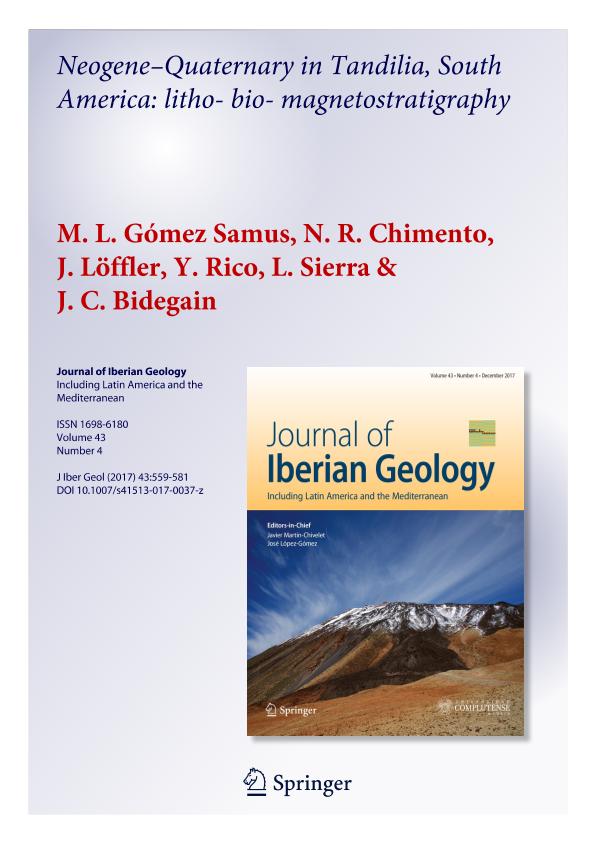Artículo
Neogene–Quaternary in Tandilia, South America: litho- bio- magnetostratigraphy
Gómez Samus, Mauro Leandro ; Chimento, Nicolás Roberto
; Chimento, Nicolás Roberto ; Löffler, J.; Rico, Y.; Sierra, Leonardo
; Löffler, J.; Rico, Y.; Sierra, Leonardo ; Bidegain, Juan Carlos
; Bidegain, Juan Carlos
 ; Chimento, Nicolás Roberto
; Chimento, Nicolás Roberto ; Löffler, J.; Rico, Y.; Sierra, Leonardo
; Löffler, J.; Rico, Y.; Sierra, Leonardo ; Bidegain, Juan Carlos
; Bidegain, Juan Carlos
Fecha de publicación:
10/2017
Editorial:
Servicio Publicaciones
Revista:
Journal of Iberian Geology
ISSN:
1886-7995
e-ISSN:
1698-6180
Idioma:
Inglés
Tipo de recurso:
Artículo publicado
Clasificación temática:
Resumen
This paper aims to contribute to the stratigraphic and geochronological knowledge of the Neogene–Quaternary of the geologic province of Tandilia by doing lithostratigraphic, paleomagnetic and paleontological analyses. Four lithostratigraphic units have been recognized. The oldest (Late Miocene) constitutes a unit composed of colluvium deposits; it lays in erosional unconformity over the Neoproterozoic rocks. This unconformity is related to important events in the Andes during the Middle-Late Miocene. Over the oldest colluvial sediments, and placed in erosional unconformity, there are sediments assigned to the Barker Formation which are essentially fluvial deposits with a development of several paleosols. Owing to the fossil remains, this unit is assigned to the Montehermosan-Chapadmalalan Stage/Age, whereas the paleomagnetic record would correspond to C3A, Gilbert and Gauss chrons. So, the age is narrowed to the timespan 7.1–3.1 Ma (Late Miocene–Early Pliocene). The Vela Formation lays in erosional unconformity over the Barker Formation. It also has fluvial origin, while the youngest unit (Las Ánimas Formation) corresponds to loess. Both units provide normal polarity and were assigned to Brunhes chron (<0.78 Ma). The Vela Formation presents fossil remains from Bonaerian-Lujanian Stage/Age and belongs to the Middle Pleistocene. The hiatus between the Barker and Vela Formations seems to be considerable: it represents at least 2.6 million years. The reason for the lack of sedimentary records is still a matter of discussion. The deposition of Las Animas Formation seems to span the last 40,000 years. However, this could be linked to a major entrance of wind-carried sediments during dry periods, including the Last Glacial Maximum. The hiatus between the Vela and Las Ánimas Formations may have been over 100,000 years.
Palabras clave:
Argentina
,
Hiatus
,
Late Cenozoic
,
Loess
,
Tandil
Archivos asociados
Licencia
Identificadores
Colecciones
Articulos(CCT - LA PLATA)
Articulos de CTRO.CIENTIFICO TECNOL.CONICET - LA PLATA
Articulos de CTRO.CIENTIFICO TECNOL.CONICET - LA PLATA
Articulos(CCT - TANDIL)
Articulos de CTRO CIENTIFICO TECNOLOGICO CONICET - TANDIL
Articulos de CTRO CIENTIFICO TECNOLOGICO CONICET - TANDIL
Citación
Gómez Samus, Mauro Leandro; Chimento, Nicolás Roberto; Löffler, J.; Rico, Y.; Sierra, Leonardo; et al.; Neogene–Quaternary in Tandilia, South America: litho- bio- magnetostratigraphy; Servicio Publicaciones; Journal of Iberian Geology; 43; 4; 10-2017; 559-581
Compartir
Altmétricas



